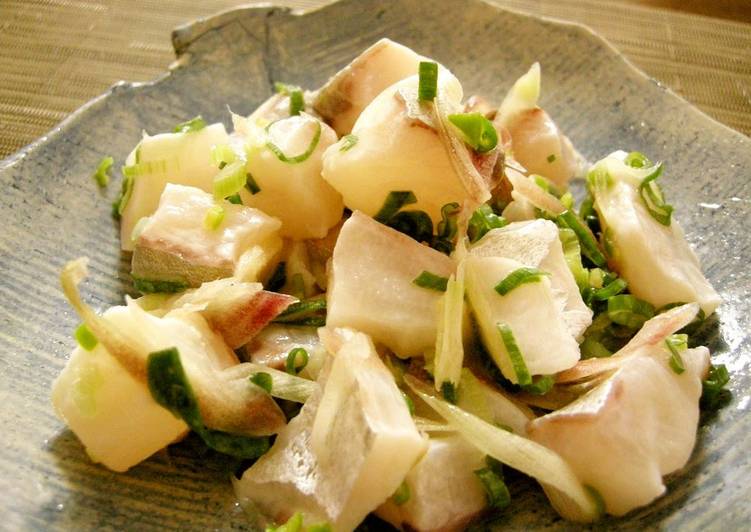| |
Japanese-Style Ceviche with Myoga Ginger. Ceviche is a traditional Latin American dish featuring raw seafood that is marinated in lime or lemon juice. This ceviche draws inspiration from Japanese cuisine and features the fresh flavors of ginger and garlic. Sometimes called myoga ginger or Japanese ginger, Myoga has a very distinctive flavor with a mild ginger overtone and zesty tang and it is shredded thinly and used in Japanese summer cooking.
 It is a deciduous herbaceous perennial native to Japan, China, and the southern part of Korea.
Only its edible flower buds and flavorful shoots are used in cooking.
Myoga is notoriously difficult to grow, so it's not surprising that people are having difficulty getting these to start.
It is a deciduous herbaceous perennial native to Japan, China, and the southern part of Korea.
Only its edible flower buds and flavorful shoots are used in cooking.
Myoga is notoriously difficult to grow, so it's not surprising that people are having difficulty getting these to start.
Hello everybody, it's John, welcome to our recipe site. Today, I'm gonna show you how to make a distinctive dish, japanese-style ceviche with myoga ginger. One of my favorites. This time, I am going to make it a bit unique. This will be really delicious.
Ceviche is a traditional Latin American dish featuring raw seafood that is marinated in lime or lemon juice. This ceviche draws inspiration from Japanese cuisine and features the fresh flavors of ginger and garlic. Sometimes called myoga ginger or Japanese ginger, Myoga has a very distinctive flavor with a mild ginger overtone and zesty tang and it is shredded thinly and used in Japanese summer cooking.
Japanese-Style Ceviche with Myoga Ginger is one of the most popular of current trending foods on earth. It's appreciated by millions every day. It is easy, it's fast, it tastes yummy. They are nice and they look fantastic. Japanese-Style Ceviche with Myoga Ginger is something that I have loved my whole life.
To begin with this recipe, we must first prepare a few ingredients. You can cook japanese-style ceviche with myoga ginger using 6 ingredients and 4 steps. Here is how you cook it.
The ingredients needed to make Japanese-Style Ceviche with Myoga Ginger:
- {Make ready 150 grams of Sea bream or salmon (sashimi-grade).
- {Get 1/2 of Lemon.
- {Make ready 1/4 tsp of Salt.
- {Prepare 1/2 of Fresh hot green chili peppers.
- {Take 1 piece of Myoga ginger.
- {Make ready 10 of cm Green onions.
Begin by preparing the pickling mixture. Place a small pan over a low heat and add the sugar and vinegar. Gently heat, stirring well until the sugar has dissolved fully. Nikkei-style preparations such as this often feature Japanese ingredients like soy sauce, togarashi, and sesame oil.
Instructions to make Japanese-Style Ceviche with Myoga Ginger:
- Cut the sea bream (or salmon) into bite-sized pieces. Finely chop the hot green chili pepper. Thinly slice the myoga ginger and green onion. Squeeze the lemon..
- Place the ingredients prepared in Step 1 into a flat container and sprinkle some salt over the top. Leave it to chill in the refrigerator for 3-4 hours. While chilling the salad, toss it a few times. After a few hours it's ready to serve!.
- The acid in the lemon juice will turn the surface of the fish white..
- This is the salmon version. I tried adding some grilled and chilled red and yellow bell peppers too..
Depending on how the fish is cut, this dish falls between a ceviche and a tiradito, a Japanese-Peruvian (or Nikkei) invention similar to ceviche, in which the fish is thinly sliced like sashimi. A delicious refreshing Japanese starter😋 Myoga's texture is very close to shallots but the taste different. Pickled Myoga Ginger - Taste of Summer in Japan ☆ 茗荷の甘酢漬け。 Japanese-style Fried Meatballs. Eggplant, Myoga, and Fresh Ginger Soup. Arugula and Fried Tofu Pouch with Vinegar Dressing.
So that is going to wrap it up with this special food japanese-style ceviche with myoga ginger recipe. Thanks so much for reading. I am confident that you will make this at home. There is gonna be interesting food in home recipes coming up. Remember to bookmark this page in your browser, and share it to your loved ones, friends and colleague. Thanks again for reading. Go on get cooking!
